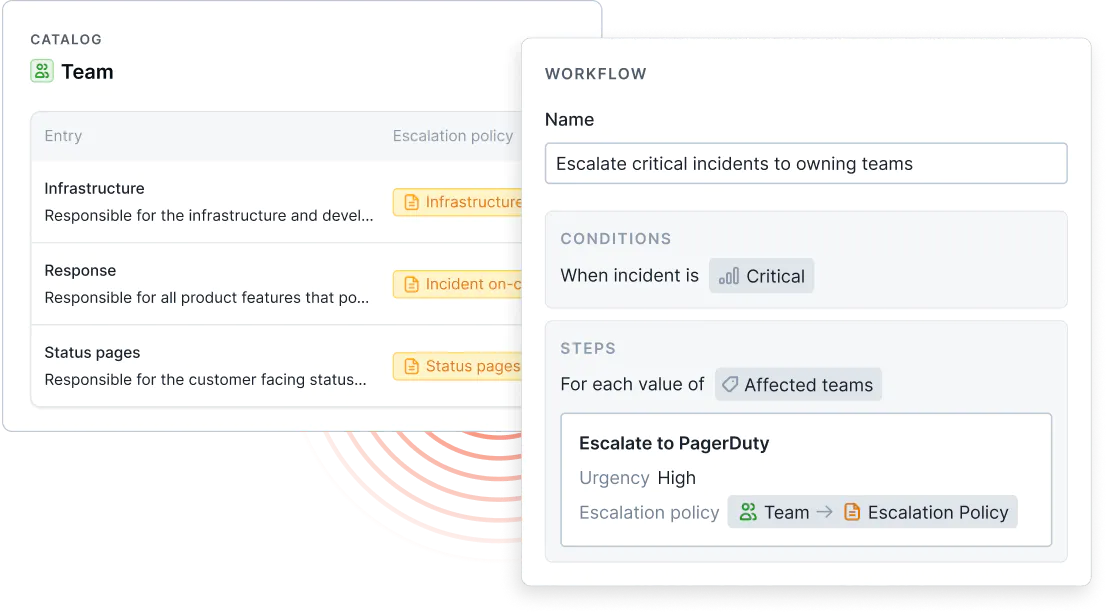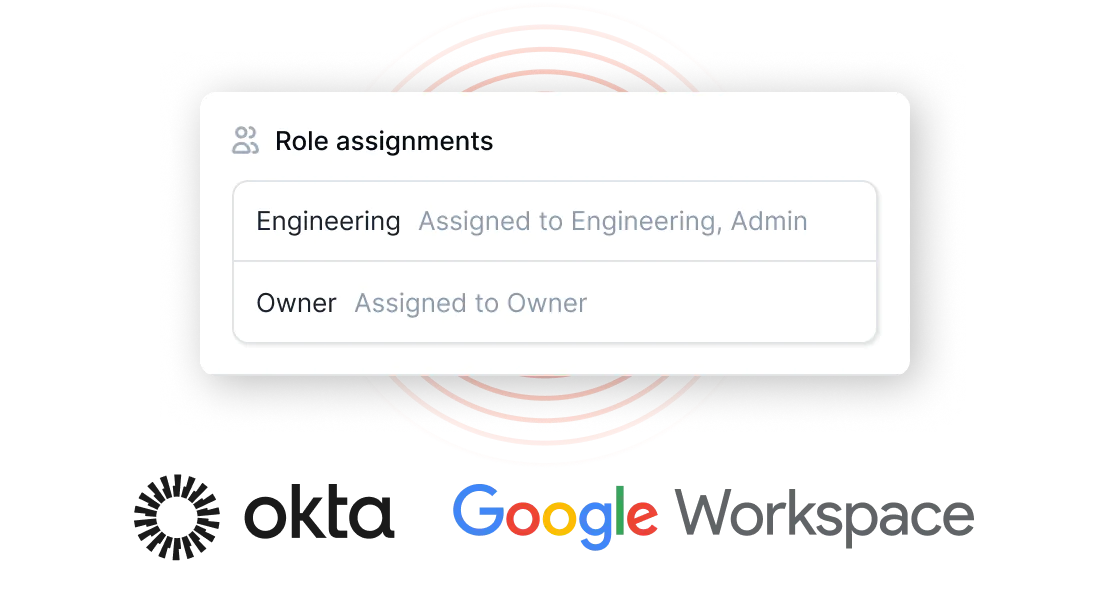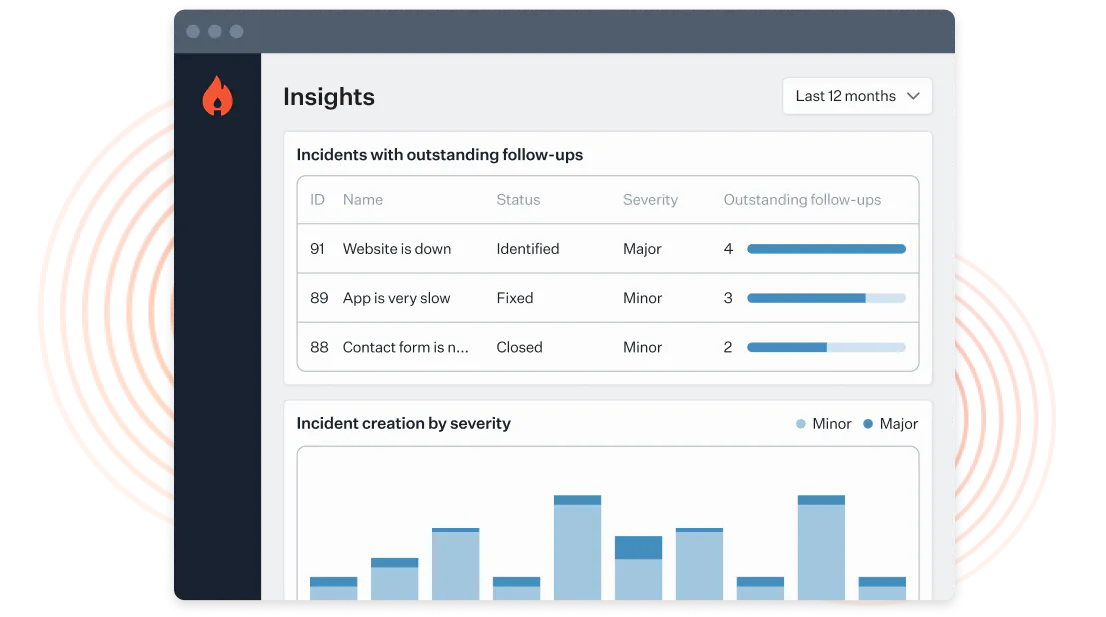incident.io: A scalable incident management solution built for enterprises

For enterprise businesses, a lot is riding on the effectiveness of their incident response.
These organizations have large customer bases, complex products, and many incidents. They also have loads of incident responders across various roles, making it difficult to coordinate internally.
Because of this, their list of “must-haves” for prospective incident management solutions is, understandably, lengthy—SCIM, SSO, service catalogs, webhooks, easy adoption, automation…the list goes on.
And with businesses looking to streamline their tech stacks, it becomes that much more important to look for a single solution that can offer all of these and then some.
But today, enterprises need much more than just a way to consolidate software, they need solutions that can make them better, smarter, and more streamlined.
That’s where incident.io comes in.
We’ve spoken to enterprise businesses and designed a feature set with everything they need to feel confident in their incident response, build customer trust, add value, and achieve operational excellence.
Enterprises have unique needs when it comes to incident management

Unsurprisingly, the needs of a 10-person startup vary widely from those of a 10,000-person enterprise.
And as businesses grow, so do the complexities of their systems and products. Think about it, 10 years ago, single-sign-on was a “nice to have.” Now, if a SaaS tool doesn’t provide the option, it can become an automatic pass in favor of one that does.
And when you add incident management into this equation, the list of needs grows even more. With that in mind, here were the guiding principles that drove us when considering how we could help enterprises best:
- Enterprises need solutions that can effectively navigate the complexities of various teams, systems, and more to help resolve incidents faster.
- Automation isn’t a nice to have anymore: it’s necessary.
- Security is critical—but there needs to be a way to efficiently grant universal permissions and exemptions.
- Learning from incidents plays a vital role in a culture of operational excellence and continuous improvement, so helping to facilitate this is key.
What incident.io offers enterprises
With incident.io, enterprise businesses can look forward to features designed to improve their incident management processes while giving customers the confidence they need with security and control.
Our goal is to ensure that everything we have adds meaningful value for companies that depend on having robust workflows, security, and processes to excel: whether it's a specific product feature or the peace of mind that a SOC 2 certification brings.
Here's what we bring to the table:
Catalog

Catalog helps address one of the biggest pain points enterprises face: contextualizing incidents and understanding how and where they fit within their organization.
For example, if incident responders cannot easily surface vital information to help them navigate incidents, such as who owns a particular service, they’ll waste loads of time chasing the wrong people about the issue.
This context-chasing extends your downtime, frustrating your customers and ultimately hurting your business.
With Catalog, this conundrum is a thing of the past.
Here’s what you can look forward to with Catalog:
- A map of everything: Catalog doesn’t just manage services. It encompasses teams, your CRM, upstream payment providers, and more. Whatever you want, you can put it here: when we say “everything,” we mean it.
- A consolidated view of your organization: Modern enterprises are incredibly connected and complex. Catalog can help you build a graph that knits together all the details of your company in a way that’s easy to understand. You tell us how everything relates to one another, and we’ll create a map that helps you understand how it’s all connected.
- A rebuilt feature set that’s Catalog aware: Our entire product has been rebuilt to account for the functionality of Catalog. For example:
- Custom Fields options are populated and automatically updated from your Catalog.
- Workflows can now leverage the map built out in your Catalog to intuitively navigate from Affected Services and Teams.
- Insights can pull your Catalog backed Custom Fields to help slice data in different ways.
You can read more about Catalog here. And if you’re curious about how our engineering team uses it, here’s a peek into just that.
Benefit for enterprises: the ability to map the complexities of everything within your organization, from critical infrastructure such as CRMs to incident observability tools like Datadog, to help power more effective incident response
Custom RBAC

With Custom RBAC, all of your role permissions are customizable!
This feature is particularly handy if there are settings you want anyone in your organization to be able to modify or if you want to restrict them to folks with Owner access only.
Additionally, you can create custom roles with specific permissions and assign those to users. For example:
- A Security custom role could grant permission to view all private incidents efficiently
- An Engineer custom role could grant permission to manage API keys and webhooks
- A Finance custom role could grant permission to efficiently manage billing settings and on-call pay reports
Benefit for enterprises: the ability to set universal, customized permissions, eliminating the need to grant them ad hoc to thousands of employees. This helps avoid situations where folks are changing areas they aren’t necessarily familiar with
SAML/SCIM

While we’re on the topic of permissions, Enterprise users can also use SCIM to control user access and authorization to incident.io.
While SCIM and SAML can be used independently, they are often combined, and we know that many enterprises want to leverage both. SCIM complements the authentication capabilities of SAML by adding automatic provisioning, de-provisioning, and authorization control.
This means that you can now use identity providers such as Okta or Google Workspaces to centrally control:
- User access to incident.io
- What the users are allowed to do once they are logged in to the dashboard
Benefit for enterprises: the ability to control who gains access to what across various teams and functions. Additionally, incident.io plugs into tools you already use to manage user access, making it much easier for IT teams to manage provisions
Audit logs

Being able to stay on top of all of the changes happening within a 50-person organization is hard. Doing the same at a 1000-employee enterprise is borderline impossible
Thanks to audit logs, customers can view and export a list of important actions to do just that!
Our audit logs track actions taken within your enterprise, such as user changes, role alterations, Workflow edits, and the installation or removal of integrations. We also track when users are granted access to private incidents, and even when users attempt to access incidents they are not permitted to.
Each audit log entry will include a simple schema detailing:
- The actor who made the change, e.g., a user
- The action that was taken
- The target or subject that was affected by the action, e.g., another user
Benefit for enterprises: visibility into the lengthy and complex list of changes in your organization. This is helpful to help identify who may have made certain changes that may have resulted in an incident or other unexpected behavior
Insights

Insights are another great feature that enterprises can take advantage of.
While it may seem counterintuitive, incidents don’t end when they’re closed out—this moment just marks the beginning of your learning opportunity. The problem is that many solutions on the market today make it difficult to glean actionable insights from incidents.
With incident.io, enterprises can look forward to a host of dashboards that highlight any areas of improvement in their incident response.
And since every minute counts, many of these dashboards are pre-built, so you can jump right in and analyze your response metrics without any overhead. Here are just a few of the metrics you can track right out of the box:
- MTTX: Data points that can help you answer questions such as, “Is our mean-time-to-respond increasing?” or “Which of our services has the lowest time-to-detection?”
- Seasonality: To help you answer questions such as, “Do our incidents concentrate around certain days of the month?” or “What do we expect incident workload to be around the Christmas holidays?”
- Pager load: A measure of how your team is responding to on-call, helping to answer questions like “What's the trend in the number of times my team is being paged?” or “Are there only a few people who have been woken up out of hours?”
- Readiness: A set of data points that gives you insight into questions like “How many people have recently responded to incidents involving this service and are likely to know how to handle future incidents?” and “Is our responder base growing or shrinking?”
Benefit for enterprises: learning from incidents to help make incident response better and more efficient across your organization
incident.io for Enterprise: scaling with you
While I covered quite a bit, these are just a few of the features developed to efficiently address the needs of enterprise-sized businesses.
So if you're looking for an incident management solution with a Catalog, SCIM, audit logs, a SOC 2 certification (and much more), all designed to help you build more resilient products: we’ve got you covered. And if we don’t have it, reach out to us—we’re always happy to build new solutions.
Ready to see how incident.io can effectively benefit your enterprise? Schedule a demo.

See related articles

Announcing Catalog – the connected map of everything in your organization
Build a connected map of everything that exists in your organization that you can easily navigate and which is available across features like Workflows, Insights, and Triggers to level up your incident response.
 Chris Evans
Chris Evans
Announcing incident.io Status Pages — powering clear external comms to build trust
With Status Pages, businesses can once again make external comms a staple of their company culture.
 Luis Gonzalez
Luis Gonzalez
Why you need an internal status page
Status pages are commonplace for companies to communicate externally to customers. But how do internal stakeholders get internal-only information: internal status pages!
 Isaac Seymour
Isaac SeymourSo good, you’ll break things on purpose
Ready for modern incident management? Book a call with one of our experts today.

We’d love to talk to you about
- All-in-one incident management
- Our unmatched speed of deployment
- Why we’re loved by users and easily adopted
- How we work for the whole organization



